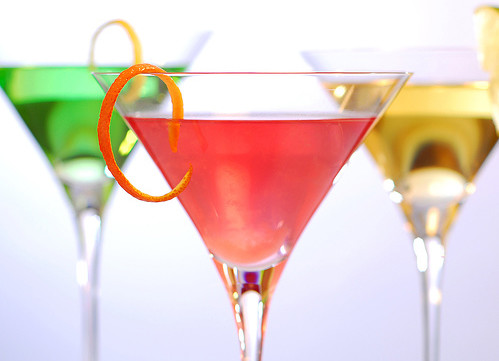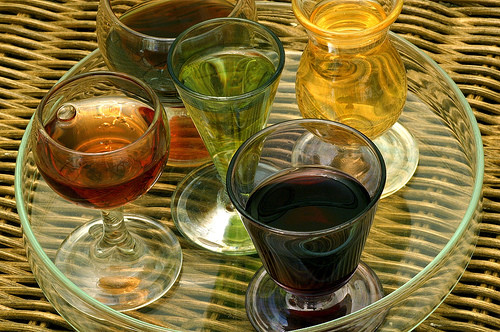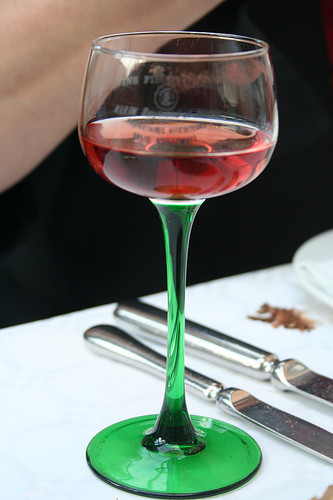 French snackChat and relaxInIn the Middle Ages, doctors prescribed various tonic drinks to patients - with cumin, thyme, nutmeg, cloves. At the same time, a special category of vermouth wines appeared, flavored with wormwood, chamomile, vanilla and other natural herbs and spices. These were the first aperitifs (from the Latin aperire - to open). Nowadays, as before, simple alcoholic drinks are usually served before meals - they refresh, invigorate and whet the appetite. In France, the choice of aperitifs is varied - from light and champagne wines to strong alcohol. Many regions have their own specialties. In wine-making regions, these are white dry wines from local grape varieties. In Burgundy and Savoy, liqueurs also serve as an aperitif. In Normandy they drink, cognac and Armagnac are offered in the provinces of the same name. In the south of France, aniseed drinks are preferred. Thus, in Marseille, the traditional aperitif is considered to be pastis Ricard, diluted with water and ice in a ratio of one to five. It was invented by Paul Ricard in the 30s of the twentieth century and quickly gained popularity not only in France, but also far beyond its borders. Another interesting version of an aperitif is a cocktail with liqueur. In Burgundy, it is called "kir" - in honor of the Dijon canon Felix Kir, who invented this drink in the middle of the last century. There are countless similar cocktails. The most exquisite is, perhaps, Kir Royal (royal kir) - champagne with the addition of blackcurrant liqueur, for example Creme de Cassis from Marie Brizard.
French snackChat and relaxInIn the Middle Ages, doctors prescribed various tonic drinks to patients - with cumin, thyme, nutmeg, cloves. At the same time, a special category of vermouth wines appeared, flavored with wormwood, chamomile, vanilla and other natural herbs and spices. These were the first aperitifs (from the Latin aperire - to open). Nowadays, as before, simple alcoholic drinks are usually served before meals - they refresh, invigorate and whet the appetite. In France, the choice of aperitifs is varied - from light and champagne wines to strong alcohol. Many regions have their own specialties. In wine-making regions, these are white dry wines from local grape varieties. In Burgundy and Savoy, liqueurs also serve as an aperitif. In Normandy they drink, cognac and Armagnac are offered in the provinces of the same name. In the south of France, aniseed drinks are preferred. Thus, in Marseille, the traditional aperitif is considered to be pastis Ricard, diluted with water and ice in a ratio of one to five. It was invented by Paul Ricard in the 30s of the twentieth century and quickly gained popularity not only in France, but also far beyond its borders. Another interesting version of an aperitif is a cocktail with liqueur. In Burgundy, it is called "kir" - in honor of the Dijon canon Felix Kir, who invented this drink in the middle of the last century. There are countless similar cocktails. The most exquisite is, perhaps, Kir Royal (royal kir) - champagne with the addition of blackcurrant liqueur, for example Creme de Cassis from Marie Brizard. French drinksStrict rules of servingThere is no such thing as an aperitif, so everyone can always choose what they like. The main thing is that the drink is not heavy and stimulates the appetite. However, these days, the role of an aperitif is not limited to this. Today, few people think about the invigorating properties of various drinks; much more important is good company and the relaxed atmosphere that they help create. “Let's drop in on me for an aperitif,” - having heard this phrase, which has become common for the French, guests do not at all expect to see tables laden with haute cuisine. On the contrary, the simpler the setting, the freer the communication. To exchange news, discuss business and problems, chat a little - that's why the French “go to an aperitif.” And the glass can contain anything – from simple water or juice to a complex cocktail. By the way, cognac-based cocktails have recently become fashionable – it is mixed with ice, lemonade, juices. Of the possible options, Martell with tonic or with fresh lemon juice is worth mentioning. Having invited you to their home for dinner, the French will not rush to serve it. First, they will offer you snacks and some light, refreshing drink that will lift your spirits, make you forget about your worries and, perhaps, cause a slight feeling of hunger. French restaurants also support the idea of an aperitif as one of the ways to have a good time. After work, it has become fashionable to go to a restaurant with friends or colleagues to chat freely in a stylish setting. And this pleasure is not so expensive. Bread, vegetables and quiche No matter how pleasant the conversation is, hunger will remind you of itself from time to time, so it is still difficult to imagine a real French aperitif without snacks. There are no strict rules on this either, although, as a rule, the French serve appetizers that are easy to serve. And, if possible, they do without cutlery. At home, they will most likely offer something simple - fresh bread, quiche, cold meats, cheeses, prepared seafood, fresh vegetables and fruits.
French drinksStrict rules of servingThere is no such thing as an aperitif, so everyone can always choose what they like. The main thing is that the drink is not heavy and stimulates the appetite. However, these days, the role of an aperitif is not limited to this. Today, few people think about the invigorating properties of various drinks; much more important is good company and the relaxed atmosphere that they help create. “Let's drop in on me for an aperitif,” - having heard this phrase, which has become common for the French, guests do not at all expect to see tables laden with haute cuisine. On the contrary, the simpler the setting, the freer the communication. To exchange news, discuss business and problems, chat a little - that's why the French “go to an aperitif.” And the glass can contain anything – from simple water or juice to a complex cocktail. By the way, cognac-based cocktails have recently become fashionable – it is mixed with ice, lemonade, juices. Of the possible options, Martell with tonic or with fresh lemon juice is worth mentioning. Having invited you to their home for dinner, the French will not rush to serve it. First, they will offer you snacks and some light, refreshing drink that will lift your spirits, make you forget about your worries and, perhaps, cause a slight feeling of hunger. French restaurants also support the idea of an aperitif as one of the ways to have a good time. After work, it has become fashionable to go to a restaurant with friends or colleagues to chat freely in a stylish setting. And this pleasure is not so expensive. Bread, vegetables and quiche No matter how pleasant the conversation is, hunger will remind you of itself from time to time, so it is still difficult to imagine a real French aperitif without snacks. There are no strict rules on this either, although, as a rule, the French serve appetizers that are easy to serve. And, if possible, they do without cutlery. At home, they will most likely offer something simple - fresh bread, quiche, cold meats, cheeses, prepared seafood, fresh vegetables and fruits. The following are suitable for aperitif snacks:French products such as pates, terrines, ham, Atlantic and Mediterranean seafood, all kinds of cheeses – from neutral Brie to bright goat cheeses, pies with cheese filling. Cheeses have long been a gastronomic symbol of France. For example, Comte is a famous boiled cheese made from cow's milk in Eastern France. It can be sliced and served with country bread or skewered with banana, apple, grapes, mango. It is generally accepted that wine and cheese are the most harmonious aperitif pair. But no French table is complete without meat delicacies. In France, there are specialized stores that sell only ready-made meat products – foie gras, cold jellied meat, various pates and terrines from poultry and game. A special place is occupied by cold and hot dishes from French pork - ham, baked ham and many other products. Home holidays, cocktail parties - an excellent occasion for original appetizers that not only attract attention, but also whet the appetite. Multi-colored canapes, tempting rolls and tartines, cheese plates, mini-barbecue with poultry and seafood - what scope for gastronomic fantasies! French restaurants offer real miniature masterpieces as aperitif snacks. They are prepared from ordinary products and delicacies, served cold and hot. They are bright and memorable, because they have the honor of opening the feast. Aperitif has become such a part of the life of the French that they dedicated an entire holiday to it. And they gave the world "French Aperitif Day", which falls on the first Thursday of June. In 2004, it was celebrated in 13 countries, including Russia. In 2005, it was celebrated on an even grander scale – in 22 countries. The point of the aperitif is for people to enjoy socializing. And to that, we are always ready to raise our glasses.
The following are suitable for aperitif snacks:French products such as pates, terrines, ham, Atlantic and Mediterranean seafood, all kinds of cheeses – from neutral Brie to bright goat cheeses, pies with cheese filling. Cheeses have long been a gastronomic symbol of France. For example, Comte is a famous boiled cheese made from cow's milk in Eastern France. It can be sliced and served with country bread or skewered with banana, apple, grapes, mango. It is generally accepted that wine and cheese are the most harmonious aperitif pair. But no French table is complete without meat delicacies. In France, there are specialized stores that sell only ready-made meat products – foie gras, cold jellied meat, various pates and terrines from poultry and game. A special place is occupied by cold and hot dishes from French pork - ham, baked ham and many other products. Home holidays, cocktail parties - an excellent occasion for original appetizers that not only attract attention, but also whet the appetite. Multi-colored canapes, tempting rolls and tartines, cheese plates, mini-barbecue with poultry and seafood - what scope for gastronomic fantasies! French restaurants offer real miniature masterpieces as aperitif snacks. They are prepared from ordinary products and delicacies, served cold and hot. They are bright and memorable, because they have the honor of opening the feast. Aperitif has become such a part of the life of the French that they dedicated an entire holiday to it. And they gave the world "French Aperitif Day", which falls on the first Thursday of June. In 2004, it was celebrated in 13 countries, including Russia. In 2005, it was celebrated on an even grander scale – in 22 countries. The point of the aperitif is for people to enjoy socializing. And to that, we are always ready to raise our glasses.

Making Money with Desserts: Success Stories
Evgeniya Polischuk (Fedutinova) instagram:@evgeniyafedutinovavk.com/janeshomebaking– It all started with baking for family and friends. Gradually, I started posting photos of my baked goods on Instagram – and orders started coming in. I made my first custom-made cake on October 13, 2014, and a little earlier I started making macaroons and cupcakes. You could say that the business “found me”, I am very […]

Soups are cold recipes with photos
Cold cucumber soup with yogurt and lemonsorbet from the chef of the restaurant La Taverna Alexander Zhurkin Photo: Getty Images Ingredients: Plain yoghurt – 125 g Cucumber – 150 g Lemon/lime sorbet – 50 g Cocktail shrimp – 24 g Fresh ginger juice – 1 g Lime juice – 5 g Fresh orange juice – 5 g Parsley – 1 g Pink pepper – 1 g Watercress – […]

barbeque kebab
Pork tenderloin in glaze Photo:Dmitry Bayrak/dbstudioPreparation time: 20 minutes + marinating time.Calories: 454 kcal per serving.For 4 servings: 4 pork tenderloins (approximately 300 g each), 1 onion, 2 cloves of garlic, 1 tsp. lemon zest, 1 tsp. lemon juice, a pinch of ground cumin, coriander and turmeric, 1 tbsp. vegetable […]

Pierre Duacan: dietary recipes: Ducane diet
Beetroot soup Photo:Season’S, Luxury Hotels RepresentationYou will need:· Boiled beetroot – 60 g· Fresh cucumbers – 20 g· Red radish – 20 g· Green onions – 10 g· Egg – 1 pc.· Drinking mineral water – 200 g· Salt – 1 gPreparation:· Boil the egg and beetroot.· Grate the cucumbers, radish and part of the beetroot. Put everything […]





